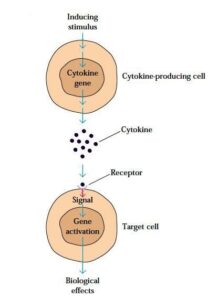Cytokines-Introduction, Properties, and Functions
Introduction
- The word cytokines are derived from the Greek word, ‘cyto’ refers to cells, and ‘kinos’ refers to movement.
- Cytokines are a group of proteins, which includes low molecular glycoproteins or regulatory proteins, which play a significant role in cell-to-cell communication.
- In response to stimuli, cytokines are secreted by WBC and other cells.
- It works as a molecular messenger, derived from a variety of cells which includes mast cells, lymphocytes, endothelial cells, macrophage, fibroblast, and granulocyte.
- The complex interaction between lymphoid cells, hemopoietic cells, and inflammatory cells, is mediated by cytokines.

Properties of the Cytokines
- Cytokines trigger the signal transduction pathway by binding to specific receptors present on the target cells, it changes the target cell’s gene expression.
- The cytokines and their specific receptors have a high affinity for their binding, and also function well at picomolar concentration, and are short-lived.
- The regulation of the intensity & duration of the immune response is determined by the cytokines, it inhibits or stimulates the activation, proliferation, and differentiation of the different types of the cells and also regulates the production of the antibodies or other cytokines.

- An individual cytokine binds to their specific receptor on the same cell membrane, exhibit autocrine action, if it binds to the nearby target cell, then action is called paracrine; in some cases, cytokines may bind to the target cells present in the distant regions of the body, then it is termed as endocrine action.

Attributes of the cytokines
- Cytokines regulate cellular functions in a coordinated way:
-
- Pleiotrophy: An individual cytokine has different effects on distinct target cells, exhibits pleiotropic action.

-
-
- Redundancy: Similar biological activity can be mediated by one or more cytokines
-

-
-
- Synergy: Combined effect on cellular function by two cytokines
-
-
-

Synergy - Antagonism: One cytokine blocks the effect of the other cytokine
-

-
-
- Cascade Induction: When individual cytokine action on target cell promotes the production of other cytokines, which may induce different target cells to produce the other cytokine.
-

Nomenclature of the cytokines
- It is based on the site of the cytokines secretion, according to that they are named which are as follows:
| Types of Cytokines | Site of Production |
| Interleukins | Produced by TH cells, and mediate communication between leukocytes |
|
Lymphokines |
Produced by Lymphocytes |
| Monokines | Produced only by monocytes |
| Interferons | Produced by an antiviral response by immune cells |
|
Chemokines |
Produced by immune cells on the response of chemoattractant to mediate chemotaxis |
Functions of the cytokines
- As we studied above, the variety of cells secretes cytokines, but the major producers are TH cells and macrophages.
- Cytokines activate the complete network of the interacting cells.

- Several physiological responses are mediated by the cytokines, which include an inflammatory response, hematopoiesis regulation, development of the immune response, control proliferation & differentiation of the cell, and wound healing.
- Cytokines activation is only limited to the antigen-activated lymphocytes, which means cytokines receptors are only expressed when the cell encounters antigen.

Cytokines Receptors
- To exhibit biological activity, cytokines bind to the specific receptors which are expressed on target cells in response to antigenic interaction.
- These receptors are expressed in a variety of cells, it is classified into five families :
- Immunoglobulin superfamily receptors.
- TNF receptor family.
- Chemokine receptor family.
- Class I cytokine receptor family( hematopoietin receptor family).
- Class II cytokine receptor family( interferon receptor family).

References and Sources
- https://www.slideshare.net/SciAmany/cytokines-and-hypersensitivity-and-disorder-of-human-immunity
- https://www.slideshare.net/sonustar3/cytokines-and-their-role-in-immune-regulation
- https://www.mdpi.com/2073-4409/10/9/2242/html
- https://www.slideshare.net/vivekaiden/cytokines-119613391
Also Read:
- Anti protozoan Drugs
- Transposable Elements
- Classification of viruses on the basis of genome
- Innate Immunity: Description, Functions and Facts
- Microbial Interactions in the Environment
- Cas9 Nuclease for Genome Editing
- The Nucleus-Detailed Structure and Functions
- what is microbiology?
- Second Golden Age of Microbiology
